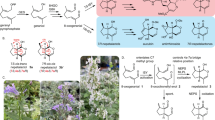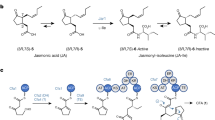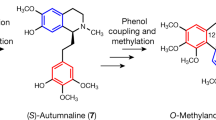Abstract
The iridoids comprise a large family of distinctive bicyclic monoterpenes that possess a wide range of pharmacological activities, including anticancer, anti-inflammatory, antifungal and antibacterial activities1,2,3,4. Additionally, certain iridoids are used as sex pheromones in agriculturally important species of aphids, a fact that has underpinned innovative and integrated pest management strategies5. To harness the biotechnological potential of this natural product class, the enzymes involved in the biosynthetic pathway must be elucidated. Here we report the discovery of iridoid synthase, a plant-derived enzyme that generates the iridoid ring scaffold, as evidenced by biochemical assays, gene silencing, co-expression analysis and localization studies. In contrast to all known monoterpene cyclases, which use geranyl diphosphate as substrate and invoke a cationic intermediate, iridoid synthase uses the linear monoterpene 10-oxogeranial as substrate and probably couples an initial NAD(P)H-dependent reduction step with a subsequent cyclization step via a Diels–Alder cycloaddition or a Michael addition. Our results illustrate how a short-chain reductase was recruited as cyclase for the production of iridoids in medicinal plants. Furthermore, we highlight the prospects of using unrelated reductases to generate artificial cyclic scaffolds. Beyond the recognition of an alternative biochemical mechanism for the biosynthesis of cyclic terpenes, we anticipate that our work will enable the large-scale heterologous production of iridoids in plants and microorganisms for agricultural5,6,7,8 and pharmaceutical1,2,3,4,9 applications.
This is a preview of subscription content, access via your institution
Access options
Subscribe to this journal
Receive 51 print issues and online access
$199.00 per year
only $3.90 per issue
Buy this article
- Purchase on Springer Link
- Instant access to full article PDF
Prices may be subject to local taxes which are calculated during checkout




Similar content being viewed by others
Accession codes
Change history
05 December 2012
The two stereoisomers in Fig. 3a were corrected.
References
Dinda, B., Chowdhury, D. R. & Mohanta, B. C. Naturally occurring iridoids, secoiridoids and their bioactivity. An updated review, part 3. Chem. Pharm. Bull. (Tokyo) 57, 765–796 (2009)
Dinda, B., Debnath, S. & Banik, R. Naturally occurring iridoids and secoiridoids. An updated review, part 4. Chem. Pharm. Bull. (Tokyo) 59, 803–833 (2011)
Dinda, B., Debnath, S. & Harigaya, Y. Naturally occurring secoiridoids and bioactivity of naturally occurring iridoids and secoiridoids. A review, part 2. Chem. Pharm. Bull. (Tokyo) 55, 689–728 (2007)
Tundis, R., Loizzo, M. R., Menichini, F. & Statti, G. A. Biological and pharmacological activities of iridoids: recent developments. Mini Rev. Med. Chem. 8, 399–420 (2008)
Dewhirst, S. Y., Pickett, J. A. & Hardie, J. in Vitamins and Hormones Vol. 83 (ed. Litwack Gerald) 551–574 (Academic Press, 2010)
Dobler, S., Petschenka, G. & Pankoke, H. Coping with toxic plant compounds—the insect’s perspective on iridoid glycosides and cardenolides. Phytochemistry 72, 1593–1604 (2011)
McElvain, S. M., Walters, P. M. & Bright, R. D. The constituents of the volatile oil of catnip. II. The neutral components. Nepetalic anhydride. J. Am. Chem. Soc. 64, 1828–1831 (1942)
Søe, A. R. B., Bartram, S., Gatto, N. & Boland, W. Are iridoids in leaf beetle larvae synthesized de novo or derived from plant precursors? A methodological approach. Isotopes Environ. Health Stud. 40, 175–180 (2004)
van der Heijden, R., Jacobs, D. I., Snoeijer, W., Hallard, D. & Verpoorte, R. The Catharanthus alkaloids: pharmacognosy and biotechnology. Curr. Med. Chem. 11, 607–628 (2004)
Chen, F., Tholl, D., Bohlmann, J. & Pichersky, E. The family of terpene synthases in plants: a mid-size family of genes for specialized metabolism that is highly diversified throughout the kingdom. Plant J. 66, 212–229 (2011)
Degenhardt, J., Köllner, T. G. & Gershenzon, J. Monoterpene and sesquiterpene synthases and the origin of terpene skeletal diversity in plants. Phytochemistry 70, 1621–1637 (2009)
Inouye, H. Neuere Ergebnisse über die biosynthese der glucoside der iridoidreihe. Planta Med. 33, 193–216 (1978)
Uesato, S., Matsuda, S., Iida, A., Inouye, H. & Zenk, M. H. Intermediacy of 10-hydroxygeraniol, 10-hydroxynerol and iridodial in the biosynthesis of ajmaline and vomilenine in Rauwolfia serpentina suspension cultures. Chem. Pharm. Bull. (Tokyo) 32, 3764–3767 (1984)
Uesato, S., Matsuda, S. & Inouye, H. Mechanism for iridane skeleton formation from acyclic monoterpenes in the biosynthesis of secologanin and vindoline in Catharanthus roseus and Lonicera morrowii. Chem. Pharm. Bull. (Tokyo) 32, 1671–1674 (1984)
Uesato, S., Ueda, S., Kobayashi, K. & Inouye, H. Mechanism of iridane skeleton formation in the biosynthesis of iridoid glucosides in Gardenia jasminoides cell cultures. Chem. Pharm. Bull. (Tokyo) 31, 4185–4188 (1983)
Uesato, S., Ikeda, H., Fujita, T., Inouye, H. & Zenk, M. H. Elucidation of iridodial formation mechanism - partial purification and characterization of the novel monoterpene cyclase from Rauwolfia serpentina cell suspension cultures. Tetrahedr. Lett. 28, 4431–4434 (1987)
Giddings, L. A. et al. A stereoselective hydroxylation step of alkaloid biosynthesis by a unique cytochrome P450 in Catharanthus roseus. J. Biol. Chem. 286, 16751–16757 (2011)
Gavidia, I., Tarrio, R., Rodriguez-Trelles, F., Perez-Bermudez, P. & Seitz, H. U. Plant progesterone 5β-reductase is not homologous to the animal enzyme. Molecular evolutionary characterization of P5βR from Digitalis purpurea. Phytochemistry 68, 853–864 (2007)
Bauer, P. et al. Highly conserved progesterone 5β-reductase genes (P5βR) from 5β-cardenolide-free and 5β-cardenolide-producing angiosperms. Phytochemistry 71, 1495–1505 (2010)
Liblikas, I. et al. Simplified isolation procedure and interconversion of the diastereomers of nepetalactone and nepetalactol. J. Nat. Prod. 68, 886–890 (2005)
Ziegler, J. & Facchini, P. J. Alkaloid biosynthesis: metabolism and trafficking. Annu. Rev. Plant Biol. 59, 735–769 (2008)
Burlat, V., Oudin, A., Courtois, M., Rideau, M. & St-Pierre, B. Co-expression of three MEP pathway genes and geraniol 10-hydroxylase in internal phloem parenchyma of Catharanthus roseus implicates multicellular translocation of intermediates during the biosynthesis of monoterpene indole alkaloids and isoprenoid-derived primary metabolites. Plant J. 38, 131–141 (2004)
Oudin, A. et al. Spatial distribution and hormonal regulation of gene products from methyl erythritol phosphate and monoterpene-secoiridoid pathways in Catharanthus roseus. Plant Mol. Biol. 65, 13–30 (2007)
Guirimand, G. et al. Optimization of the transient transformation of Catharanthus roseus cells by particle bombardment and its application to the subcellular localization of hydroxymethylbutenyl 4-diphosphate synthase and geraniol 10-hydroxylase. Plant Cell Rep. 28, 1215–1234 (2009)
Thorn, A. et al. The crystal structure of progesterone 5β-reductase from Digitalis lanata defines a novel class of short chain dehydrogenases/reductases. J. Biol. Chem. 283, 17260–17269 (2008)
Kim, H. J., Ruszczycky, M. W. & Liu, H.-W. Current developments and challenges in the search for a naturally selected Diels-Alderase. Curr. Opin. Chem. Biol. 16, 124–131 (2012)
Cheng, J. Z., Coyle, C. M., Panaccione, D. M. & O’Connor, S. E. A role for old yellow enzyme in ergot alkaloid biosynthesis. J. Am. Chem. Soc. 132, 1776–1777 (2010)
Liscombe, D. K. & O’Connor, S. E. A virus-induced gene silencing approach to understanding alkaloid metabolism in Catharanthus roseus. Phytochemistry 72, 1969–1977 (2011)
Góngora-Castillo, E. et al. Genomic approaches for interrogating the biochemistry of medicinal plant species. Methods Enzymol. 517, 139–159 (2012)
Nour-Eldin, H. H., Geu-Flores, F. & Halkier, B. A. USER cloning and USER fusion: the ideal cloning techniques for small and big laboratories. Methods Mol. Biol. 643, 185–200 (2010)
Guirimand, G. et al. Strictosidine activation in Apocynaceae: towards a “nuclear time bomb”? BMC Plant Biol. 10, 182 (2010)
Guirimand, G. et al. Spatial organization of the vindoline biosynthetic pathway in Catharanthus roseus. J. Plant Physiol. 168, 549–557 (2011)
Mahroug, S., Courdavault, V., Thiersault, M., St-Pierre, B. & Burlat, V. Epidermis is a pivotal site of at least four secondary metabolic pathways in Catharanthus roseus aerial organs. Planta 223, 1191–1200 (2006)
Acknowledgements
The present study was funded by the Danish Council for Independent Research (Natural Sciences) through Postdoctoral Fellowship 10-082858 granted to F.G.-F. Additional funding was received from the NIH (GM074820), the j004561SRC (BB/J004561/1 and BB/J009091/1) and the John Innes Foundation. This work was conducted under Defra Plant Health Licence PHSI 449/6612(07/2011). W.S.G. gratefully acknowledges a National Science Foundation Predoctoral Fellowship. Y.C. would like to thank the NSF for grant DMS-1209112. K. R. Chauhan is acknowledged for providing initial nepetalactol samples. We thank S. Fairhurst, L. Hill and A. Jones for NMR, LC–MS and GC–MS assistance, respectively. J. Ward and N. Hawkins are acknowledged for the GC–MS-based high-resolution mass spectra (HRMS) of synthesized compounds. R. Buell and E. Góngora-Castillo provided many helpful discussions on the transcriptome data. The purified EasA protein was provided J. Z. Cheng, to whom we are deeply indebted. S.E.O. receives salary support through a synergy initiative between the John Innes Centre and the University of East Anglia.
Author information
Authors and Affiliations
Contributions
F.G.-F. and S.E.O. conceived the project; C.W., Y.C. and F.G.-F. constructed the G10H mutual ranking list; E.N. cloned the iridoid synthase from cDNA; F.G.-F. and W.S.G. expressed the recombinant protein; N.H.S. performed all chemical synthesis; F.G.-F. carried out all enzyme assays, enzyme-based synthesis, VIGS experiments, and feeding experiments; V.C. performed the sub-cellular localization studies; V.B. carried out the cellular localization studies; F.G.-F. and S.E.O. drafted the manuscript; and S.E.O. acted as overall study director.
Corresponding author
Ethics declarations
Competing interests
The authors declare no competing financial interests.
Supplementary information
Supplementary Information
This file contains Supplementary Figures 1-8, Supplementary Tables 1-2, Supplementary Text, which explains the methods used to synthesize the chemicals used in the main paper and additional references. (PDF 2146 kb)
Rights and permissions
About this article
Cite this article
Geu-Flores, F., Sherden, N., Courdavault, V. et al. An alternative route to cyclic terpenes by reductive cyclization in iridoid biosynthesis. Nature 492, 138–142 (2012). https://doi.org/10.1038/nature11692
Received:
Accepted:
Published:
Issue Date:
DOI: https://doi.org/10.1038/nature11692
This article is cited by
-
A fused hybrid enzyme of 8-hydroxygeraniol oxidoreductase (8HGO) from Gardenia jasminoides and iridoid synthase (ISY) from Catharanthus roseus significantly enhances nepetalactol and iridoid production
Planta (2024)
-
Biosynthesis, natural distribution, and biological activities of acyclic monoterpenes and their derivatives
Phytochemistry Reviews (2023)
-
Biotechnological advances for improving natural pigment production: a state-of-the-art review
Bioresources and Bioprocessing (2022)
-
Reconstitution of monoterpene indole alkaloid biosynthesis in genome engineered Nicotiana benthamiana
Communications Biology (2022)
-
Biocatalytic routes to stereo-divergent iridoids
Nature Communications (2022)
Comments
By submitting a comment you agree to abide by our Terms and Community Guidelines. If you find something abusive or that does not comply with our terms or guidelines please flag it as inappropriate.



